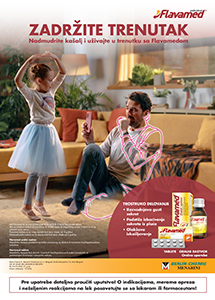SERUM URIC ACID, TRIGLYCERIDES AND TOTAL BILIRUBIN ARE ASSOCIATED WITH HEPATIC STEATOSIS INDEX IN ADOLESCENT POPULATION
Keywords:
dyslipidemia, inflammation, hepatic steatosis, oxidative stressAbstract
Objective: Given the fact that pathophysiological background of non-alcoholic fatty liver disease is not completely elucidated, we aimed to explore the relationship between dyslipidemia, inflammation and oxidative stress with hepatic steatosis index (HSI) in the cohort of adolescent population in Montenegro.
Patients and Methods: A total of 136 adolescents participated in this cross-sectional study. Anthropometric and biochemical markers were provided. HSI was calculated. Associations of biochemical parameters with HSI were tested using univariable and multivariable ordinal regression analysis for HSI tertiles as dependent variable.
Results: Adjusted odds for uric acid (OR=2.641, P=0.007) and for triglycerides, (OR=5.275, P=0.008) showed their highly significant positive associations with HSI. On the contrary, adjusted odds for bilirubin (OR=0.923, P=0.015), indicated its significant negative independent association with HSI. Although C-reactive protein correlated positively with HSI in univariable analysis (OR=1.962, P<0.001), it lost its independent prediction for HSI in multivariable analysis (OR=1.442, P=0.130).
Conclusion: Serum uric acid, triglycerides and total bilirubin are associated with HSI in adolescents. Longitudinal studies are needed to confirm the causal relationship between mentioned biomarkers and hepatic steatosis and to further explore its diagnostic potential in NAFLD in young population.
References
Tzifi F, Fretzayas A, Chrousos G, Kanaka-Gantenbein C. Non-alcoholic fatty liver infiltration in children: an underdiagnosed evolving disease. Hormones (Athens). 2019;18(3):255‐265. doi:10.1007/s42000-019-00107-7.
Nobili V, Alisi A, Valenti L, Miele L, Feldstein AE, Alkhouri N. NAFLD in children: new genes, new diagnostic modalities and new drugs. Nat Rev Gastroenterol Hepatol. 2019;16(9):517-530. doi: 10.1038/s41575-019-0169-z.
Nobili V, Mantovani A, Cianfarani S, Alisi A, Mosca A, Sartorelli MR, et al. Prevalence of prediabetes and diabetes in children and adolescents with biopsy-proven non-alcoholic fatty liver disease. J Hepatol. 2019;71(4):802-810. doi: 10.1016/j.jhep.2019.06.023.
Cioffi CE, Welsh JA, Cleeton RL, Caltharp SA, Romero R, Wulkan ML, et al. Natural History of NAFLD Diagnosed in Childhood: A Single-Center Study. Children (Basel). 2017;4(5):34. doi: 10.3390/children4050034.
Smith SK, Perito ER. Nonalcoholic Liver Disease in Children and Adolescents. Clin Liver Dis. 2018;22(4):723‐733. doi:10.1016/j.cld.2018.07.001.
Chen HY, Su J, Liu H. A study of the correlation of waist circumference with metabolic risks among non-obese populations. Eur Rev Med Pharmacol Sci. 2019;23(10):4391-4397. doi: 10.26355/eurrev_201905_17946.
Gualtieri P, Tarsitano MG. Merra G, Avolio E, Di Renzo L. The importance of a correct diagnosis of obesity. Eur Rev Med Pharmacol Sci. 2020;24(10):5199-5200.
doi: 10.26355/eurrev_202005_21300.
Tong J, Guo JJ. Key molecular pathways in the progression of non-alcoholic steatohepatitis. Eur Rev Med Pharmacol Sci. 2019;23(19):8515-8522. doi: 10.26355/eurrev_201910_19165.
Klisic A, Kocic G, Kavaric N, Jovanovic M, Stanisic V, Ninic A. Body mass index is independently associated with xanthine oxidase activity in overweight/obese population. Eat Weight Disord – St. 2020;25:9-15. doi: 10.1007/s40519-018-0490-5.
Ates E, Set T, Karahan CS, Bicer C, Erel Ö. Thiol/disulphide homeostasis, ischemia modified albumin and peroxidase as oxidative stress markers in women with obesity with insulin resistance. J Med Biochem. 2019;38:445-451. doi:10.2478/jomb-2019-0015.
Klisic A, Kocic G, Kavaric N, Pavlovic R, Soldatovic I, Ninic A. Nitric oxide products are not associated with metabolic syndrome. J Med Biochem. 2019;38:361-367. doi: 10.2478/jomb-2018-0035.
Klisic A, Kavaric N, Soldatovic I, Ninic A, Kotur-Stevuljevic J. Retinol-binding protein 4 better correlates with metabolic syndrome than cystatin C. J Lab Med. 2019;43(1):29-34. doi: https://doi.org/10.1515/labmed-2018-0042.
Nasser HA, Ezz NZA, Abdel-Mageed HM, Radwan RA. Body Mass Index and C-reactive Protein Are Potential Predictors of Asthma Development in Egyptian Polycystic Ovary Syndrome Patients. J Med Biochem. 2019;38(4):427‐436. doi:10.2478/jomb-2019-0012.
Radwan RA, Abuelezz NZ, Abdelraouf SM, Bakeer EM, Rahman AAAE. Decreased Serum Level of Gamma-amino Butyric Acid in Egyptian Infertile Females with Polycystic Ovary Syndrome is Correlated with Dyslipidemia, Total Testosterone and 25(OH) Vitamin D Levels. J Med Biochem. 2019;38(4):512‐518. doi:10.2478/jomb-2018-0051.
Klisic A, Kavaric N, Stanisic V, Vujcic S, Spasojevic-Kalimanovska V, Ninic A, et al. Endocan and a novel score for dyslipidemia, oxidative stress and inflammation (DOI score) are independently correlated with glycated hemoglobin (HbA1c) in patients with prediabetes and type 2 diabetes. Arch Med Sci. 2020;16:42-50. doi: https://doi.org/10.5114/aoms.2019.87541.
Bego T, Čaušević A, Dujić T, Malenica M, Velija-Asimi Z, Prnjavorac B, et al. Association of FTO gene variant (rs8050136) with type 2 diabetes and markers of obesity, glycaemic control and inflammation. J Med Biochem. 2019;38:153-163. doi:10.2478/jomb-2018-0023.
Maksimovic M, Vlajinac H, Radak Dj, Marinkovic J, Maksimovic J, Jorga J. Association of overweight and obesity with cardiovascular risk factors in patients with atherosclerotic diseases. J Med Biochem 2020;38:215–223. doi: 10.2478/jomb-2019-0027.
Ragino YI, Shramko VS, Stakhneva EM, Chernyak EI, Morozov SV, Shakhtshneider EV, et al. Changes in the blood fatty-acid profile associated with oxidative-antioxidant disturbances in coronary atherosclerosis. J Med Biochem. 2020;39:46-53. doi: 10.2478/jomb-2019-0010.
Ninić A, Bogavac-Stanojević N, Sopić M, Munjas J, Kotur-Stevuljević J, Miljković M, et al. Superoxide Dismutase Isoenzymes Gene Expression in Peripheral Blood Mononuclear Cells in Patients with Coronary Artery Disease. J Med Biochem. 2019;38:284‐291. doi:10.2478/jomb-2018-0041.
Klisic A, Kavaric N, Abenavoli L, Stanisic V, Spasojevic-Kalimanovska V, Kotur-Stevuljevic J, et al. Is endocan a novel potential biomarker of liver steatosis and fibrosis? J Med Biochem. 2020;39(3):363-371. doi: 10.2478/jomb-2019-0042.
Klisic A, Isakovic A, Kocic G, Kavaric N, Jovanovic M, Zvrko E, et al. Relationship between Oxidative Stress, Inflammation and Dyslipidemia with Fatty Liver Index in Patients with Type 2 Diabetes Mellitus. Exp Clin Endocrinol Diabetes. 2018;126(06): 371-378. doi: 10.1055/s-0043-118667.
Ferraioli G, Calcaterra V, Lissandrin R, Guazzotti M, Maiocchi L, Tinelli C, et al. Noninvasive assessment of liver steatosis in children: the clinical value of controlled attenuation parameter. BMC Gastroenterol. 2017;17(1):61. doi: 10.1186/s12876-017-0617-6.
Lee JH, Kim D, Kim HJ, Lee CH, Yang JI, Kim W, et al. Hepatic steatosis index: a simple screening tool reflecting nonalcoholic fatty liver disease. Dig Liver Dis. 2010;42(7):503–508. doi:10.1016/j.dld.2009.08.002.
Zanza C, Thangathurai J, Audo A, Muir HA, Candelli M, Pignataro G, et al. Oxidative stress in critical care and vitamins supplement therapy: "a beneficial care enhancing". Eur Rev Med Pharmacol Sci. 2019;23:7703-7712. doi:10.26355/eurrev_201909_18894.
Medrano M, Arenaza L, Migueles JH, Rodríguez-Vigil B, Ruiz JR, Labayen I. Associations of physical activity and fitness with hepatic steatosis, liver enzymes, and insulin resistance in children with overweight/obesity. Pediatr Diabetes. 2020;21(4):565-574. doi: 10.1111/pedi.13011.
Juhas I, Skof B, Popović D, Matić M, Janković N. Effects of an eight week-exercise program on parameters of the lipid profile of female students. J Med Biochem. 2020;39:40–45. doi: 10.2478/jomb-2019-0006.
Klisic A, Kotur-Stevuljevic J, Kavaric N, Martinovic M, Matic M. The association between follicle stimulating hormone and glutathione peroxidase activity is dependent on abdominal obesity in postmenopausal women. Eat Weight Disord-St 2018;23:133-141. doi: 10.1007/s40519-016-0325-1.
Sartorio A, Del Col A, Agosti F, Mazzilli G, Bellentani S, Tiribelli C, et al. Predictors of non-alcoholic fatty liver disease in obese children. Eur J Clin Nutr. 2007;61(7):877-883. doi: 10.1038/sj.ejcn.1602588.
Arslan N, Büyükgebiz B, Oztürk Y, Cakmakçi H. Fatty liver in obese children: prevalence and correlation with anthropometric measurements and hyperlipidemia. Turk J Pediatr. 2005;47(1):23-27. PMID: 15884625.
Klisic A, Kavaric N, Ninic A. Predictive values of serum uric acid and alanine-aminotransferase for fatty liver index (FLI) in Montenegrin population. J Med Biochem. 2019;38(4):407-417. doi: 10.2478/jomb-2018-0054.
Ozsu E, Yazıcıoğlu B. Obese boys with low concentrations of high-density lipoprotein cholesterol are at greater risk of hepatosteatosis. Hormones (Athens). 2019;18(4):477-484. doi: 10.1007/s42000-019-00152-2.
Gong S, Song J, Wang L, Zhang S, Wang Y. Hyperuricemia and risk of non-alcoholic fatty liver disease: a systematic review and meta-analysis. Eur J Gastroenterol Hepatol. 2016;28(2):132-138. doi:10.1097/MEG.0000000000000507.
Čolak E, Pap D, Nikolić Lj, Vicković S. The impact of obesity to antioxidant defense parameters in adolescents with increased cardiovascular risk. J Med Biochem. 2020; 39:346-354. doi: 10.2478/jomb-2019-0051.
Čolak E, Pap D. The role of oxidative stress in the development of obesity and obesity-related metabolic disorders. J Med Biochem. 2020; https://doi.org/10.5937/jomb0-24652
Sayın S, Kutlu R, Kulaksızoğlu M. The relationship between sex steroids, insulin resistance and body compositions in obese women: A case-control study. J Med Biochem. 2020;39:25-31. doi: 10.2478/jomb-2019-0009.
Klisic A, Kavaric N, Ninic A. Are liver function biomarkers independently associated with Framingham risk score in female population? Srpski arhiv za celokupno lekarstvo 2020; https://doi.org/10.2298/SARH181120006K
Biyik Z, Guney I. Lipid accumulation product and visceral adiposity index: two new indices to predict metabolic syndrome in chronic kidney disease. Eur Rev Med Pharmacol Sci. 2019;23(5):2167-2173. doi: 10.26355/eurrev_201903_17262.
Klisic A, Abenavoli L, Fagoonee S, Kavaric N, Kocic G, Ninić A. Older age and HDL-cholesterol as independent predictors of liver fibrosis assessed by BARD score. Minerva Med. 2019;110(3):191-198. doi: 10.23736/S0026-4806.19.05978-0.
Nobili V, Parola M, Alisi A, Marra F, Piemonte F, Mombello C, et al. Oxidative stress parameters in paediatric non-alcoholic fatty liver disease. Int J Mol Med. 2010;26(4):471-476. doi: 10.3892/ijmm_00000487.
Puri K, Nobili V, Melville K, Corte CD, Sartorelli MR, Lopez R, et al. Serum bilirubin level is inversely associated with nonalcoholic steatohepatitis in children. J Pediatr Gastroenterol Nutr. 2013;57(1):114-118. doi: 10.1097/MPG.0b013e318291fefe.
Klisic A, Kavaric N, Soldatovic I, Bjelakovic B, Kotur-Stevuljevic J. Relationship between cardiovascular risk score and traditional and nontraditional cardiometabolic parameters in obese adolescent girls. J Med Biochem. 2016;35(3):282-292. doi: 10.1515/jomb-2016-0005.
Mirjanic-Azaric B, Vasic N, Cerne D, Kos J, Bogavac-Stanojevic N. Plasma Cathepsin S is Associated with High-density Lipoprotein Cholesterol and Bilirubin in Patients with Abdominal Aortic Aneurysms. J Med Biochem. 2019;38(3):268-275. doi: 10.2478/jomb-2018-0039.
Koot BG, van der Baan-Slootweg OH, Bohte AE, Nederveen AJ, van Werven JR, Tamminga-Smeulders CL, et al. Accuracy of prediction scores and novel biomarkers for predicting nonalcoholic fatty liver disease in obese children. Obesity (Silver Spring). 2013;21(3):583–590. doi:10.1002/oby.20173.





